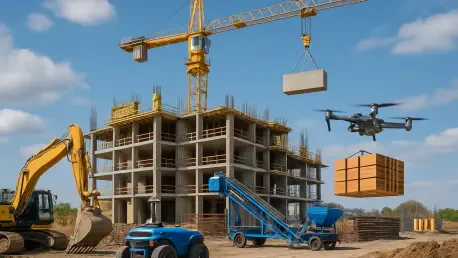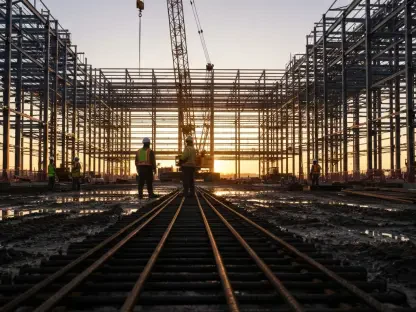In a landscape where economic challenges like high interest rates and tight liquidity loom large, the U.S. built environment sector has defied expectations with an astonishing surge in venture capital activity, reaching a staggering $3.96 billion in the second quarter of this year alone. This remarkable growth, particularly within construction technology, is fueled by a powerful force: artificial intelligence (AI) and machine learning (ML). These technologies are not just buzzwords but transformative tools reshaping how projects are managed, buildings are designed, and infrastructure is maintained. Investor confidence in AI-driven startups has soared, with a significant portion of capital flowing into innovative solutions that promise to enhance efficiency and tackle long-standing industry inefficiencies. As the sector continues to break records, the question arises: how exactly is AI propelling this financial boom, and what does it mean for the future of construction and beyond? This exploration delves into the dynamics behind the numbers and the technological shifts driving unprecedented change.
AI as the Catalyst for Unprecedented Investment Growth
Venture capital inflows into the U.S. built environment sector have skyrocketed, with a reported $3.96 billion invested in Q2 of this year, marking a 75.2% increase compared to the same period last year. This growth is accompanied by a 41% rise in deal volume, jumping from 113 to 159 transactions. What stands out most is the dominant role of AI and ML technologies in attracting this capital. Nearly 70% of the deals—110 in total—involved companies leveraging these cutting-edge tools, with approximately $2.71 billion, or 68% of the total funds, directed toward AI-integrated ventures. Despite economic headwinds, the sector shows no signs of slowing down, poised to eclipse previous records. This surge reflects a deep investor belief in AI’s potential to revolutionize operational models across construction, building, and infrastructure industries, positioning technology as a critical driver of scalability and innovation in a traditionally slow-to-adapt field.
The momentum behind AI investments signals a broader shift in market dynamics, where technological innovation is seen as a solution to persistent challenges like labor shortages and project delays. Beyond the sheer volume of capital, the focus on AI-driven startups highlights a strategic pivot toward automation and data-driven decision-making. These technologies are enabling everything from predictive analytics to real-time project monitoring, fundamentally altering how stakeholders approach risk and efficiency. While the numbers are impressive, there’s a lingering question about sustainability—whether this enthusiasm represents a long-term trend or a fleeting spike. Stabilizing deal sizes over recent years suggest a maturing market, where investors are beginning to balance excitement with pragmatism. As AI continues to penetrate various sub-sectors, its role in attracting capital underscores a transformative era for the built environment, promising not just financial growth but a redefinition of industry standards.
Construction Tech Leads the AI Revolution
Among the sub-sectors of the built environment, construction tech stands out as the primary beneficiary of AI-driven investments, securing over twice the capital inflows compared to building tech and surpassing infrastructure tech by more than $100 million. The diversity of AI applications in this space is striking, ranging from project management and workforce coordination to accounting, payments, and even advanced equipment and robotics. Such versatility makes construction tech a hotbed for innovation, drawing significant investor interest. The ability of AI to streamline complex workflows, reduce errors, and optimize resource allocation has positioned this sector as a leader in adopting digital transformation. With nearly 70% of recent deals tied to AI solutions, the financial backing reflects strong confidence in technology’s capacity to address critical pain points like cost overruns and scheduling conflicts.
While construction tech dominates, the impact of AI is not uniform across all areas of application, with certain niches showing accelerated growth. Tools powered by machine learning are increasingly used to predict project risks before they materialize, allowing companies to mitigate issues proactively. Additionally, robotics integrated with AI are transforming on-site operations by automating repetitive tasks, thereby enhancing safety and productivity. This technological edge is not merely about efficiency; it’s about reimagining the construction process in a way that aligns with modern demands for speed and sustainability. As capital continues to flow disproportionately into construction tech, it’s clear that investors see this sector as the vanguard of AI’s potential, setting a precedent for how technology can reshape even the most traditional industries. The ripple effects of these advancements are likely to influence adjacent fields, pushing the entire built environment toward a more interconnected, tech-driven future.
Emerging AI Trends in Building and Infrastructure Tech
Though construction tech captures the lion’s share of AI investments, building tech is also experiencing a notable, if less dominant, integration of these technologies. AI and ML startups in this sub-sector accounted for nearly 44% of total transactions, reflecting growing interest despite lower capital inflows compared to construction. Applications here often focus on smart building systems, energy efficiency, and occupant experience enhancements, leveraging AI to optimize heating, ventilation, and security through real-time data analysis. This trend indicates a shift toward creating environments that are not only functional but also adaptive to user needs. While the financial commitment may be smaller, the steady adoption of AI suggests a foundation for future growth, particularly as urbanization drives demand for intelligent, sustainable building solutions that can scale with population pressures.
Infrastructure tech, while trailing behind in AI adoption, presents untapped potential, especially in areas like energy and utilities. AI is enhancing operations through innovations such as smart grids, predictive maintenance, and renewable energy integration, which are critical for modernizing aging systems. Additionally, tools for asset health management, powered by data-driven diagnostics and predictive analytics, are gaining traction, alongside geospatial information systems and real-time infrastructure modeling. Though investment levels are lower compared to construction tech, the strategic importance of infrastructure cannot be understated, as it underpins economic stability and growth. The gradual integration of AI in this space hints at a long-term transformation, where technology could bridge gaps in efficiency and resilience. As investor interest slowly builds, infrastructure tech may emerge as a key area for AI-driven innovation in the coming years.
Navigating the Future of AI-Driven Transformation
Reflecting on the remarkable strides made in Q2, it’s evident that AI and ML have become indispensable forces in propelling the U.S. built environment sector to new financial heights, with a $3.96 billion venture capital boom marking a historic milestone. Construction tech has led the charge, harnessing a wide array of AI applications to redefine industry practices, while building and infrastructure tech follow with promising, albeit slower, adoption. The 41% increase in deal volume has underscored the breadth of investor enthusiasm, though stabilizing deal sizes hint at a market finding its footing amid rapid growth. Looking ahead, stakeholders should prioritize strategic partnerships between tech startups and traditional firms to ensure scalable implementation of AI solutions. Focusing on niche areas like energy management and asset optimization could unlock further potential, especially in under-invested sub-sectors. As the industry evolves, continuous evaluation of investment trends will be crucial to distinguish between fleeting hype and sustainable progress.









